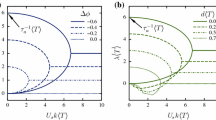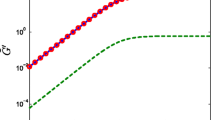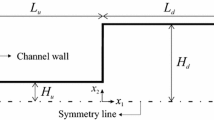Abstract
A simple kinetic model is presented for the shear rheology of a dilute suspension of particles swimming at low Reynolds number. If interparticle hydrodynamic interactions are neglected, the configuration of the suspension is characterized by the particle orientation distribution, which satisfies a Fokker-Planck equation including the effects of the external shear flow, rotary diffusion, and particle tumbling. The orientation distribution then determines the leading-order term in the particle extra stress in the suspension, which can be evaluated based on the classic theory of Hinch and Leal (J Fluid Mech 52(4):683–712, 1972), and involves an additional contribution arising from the permanent force dipole exerted by the particles as they propel themselves through the fluid. Numerical solutions of the steady-state Fokker-Planck equation were obtained using a spectral method, and results are reported for the shear viscosity and normal stress difference coefficients in terms of flow strength, rotary diffusivity, and correlation time for tumbling. It is found that the rheology is characterized by much stronger normal stress differences than for passive suspensions, and that tail-actuated swimmers result in a strong decrease in the effective shear viscosity of the fluid.





Similar content being viewed by others
References
Hill NA, Pedley TJ (2005) Bioconvection. Fluid Dyn Res 37:1–20
Kils U (1993) Formation of micropatches by zooplankton-driven microturbulences. Bull Mar Sci 53:160–169
Paxton WF, Kistler KC, Olmeda CC, Sen A, St Angelo SK, Cao Y, Mallouk TE, Lammert PE, Crespi VH (2004) Catalytic nanomotors: autonomous movement of striped nanorods. J Am Chem Soc 126:13424
Kim MJ, Breuer KS (2004) Enhanced diffusion due to motile bacteria. Phys Fluids 16:L78
Darnton N, Turner L, Breuer K, Berg HC (2004) Moving fluid with bacterial carpets. Biophys J 86:1863–1870
Mendelson NH, Bourque A, Wilkening K, Anderson KR, Watkins JC (1999) Organized cell swimming motions in Bacillus subtilis colonies: patterns of short-lived whirls and jets. J Bacteriol 181:600
Dombrowski C, Cisneros L, Chatkaew S, Goldstein RE, Kessler JO (2004) Self-concentration and large-scale coherence in bacterial dynamics. Phys Rev Lett 93:098103
Cisneros LH, Cortez R, Dombrowski C, Wolgemuth CW, Kessler JO, Golstein RE (2007) Fluid dynamics of self-propelled microorganisms, from individuals to concentrated populations. Exp Fluids 43:737–753
Wu XL, Libchaber A (2000) Particle diffusion in a quasi-two-dimensional bacterial bath. Phys Rev Lett 84:3017
Hernández-Ortiz JP, Stoltz CG, Graham MD (2005) Transport and collective dynamics in suspensions of confined self-propelled particles. Phys Rev Lett 95:203501
Saintillan D, Shelley MJ (2007) Orientational order and instabilities in suspensions of self-locomoting rods. Phys Rev Lett 99:058102
Saintillan D, Shelley MJ (2008) Instabilities and pattern formation in active particle suspensions: kinetic theory and continuum simulations. Phys Rev Lett 100:178103
Saintillan D, Shelley MJ (2008) Instabilities, pattern formation and mixing in active suspensions. Phys Fluids 20:123304
Ishikawa T, Locsei JT, Pedley TJ (2008) Development of coherent structures in concentrated suspensions of swimming model micro-organisms. J Fluid Mech 615:401–431
Mehandia V, Nott PR (2008) The collective dynamics of self-propelled particles. J Fluid Mech 595:239–264
Wolgemuth CW (2008) Collective swimming and the dynamics of bacterial turbulence. Biophys J 95:1564–1574
Hatwalne Y, Ramaswamy S, Rao M, Aditi Simha R (2004) Rheology of active-particle suspensions. Phys Rev Lett 92:118101
Ishikawa T, Pedley TJ (2007) The rheology of a semi-dilute suspension of swimming model micro-organisms. J Fluid Mech 588:399–435
Haines BM, Aranson IS, Berlyland L, Karpeev DA (2008) Effective viscosity of dilute bacterial suspensions: a two-dimensional model. Phys Biol 5:1–9
Batchelor GK (1974) Transport properties of two-phase materials with random structure. Annu Rev Fluid Mech 6:227–255
Hinch EJ, Leal LG (1972) The effect of Brownian motion on the rheological properties of a suspension of non-spherical particles. J Fluid Mech 52(4):683–712
Brenner H (1974) Rheology of a dilute suspension of axisymmetric Brownian particles. Int J Multiph Flow 1:195–341
Hinch EJ, Leal LG (1975) Constitutive equations in suspension mechanics. Part 1. General formulation. J Fluid Mech 71(3):481–495
Hinch EJ, Leal LG (1976) Constitutive equations in suspension mechanics. Part 2. Approximate forms for a suspension of rigid particles affected by Brownian rotations. J Fluid Mech 76(1):187–208
Chen SB, Koch DL (1996) Rheology of dilute suspensions of charged fibers. Phys Fluids 8(11):2792–2807
Chen SB, Jiang L (1999) Orientation distribution in a dilute suspension of fibers subject to simple shear flow. Phys Fluids 11(10):2878–2890
Doi M, Edwards SF (1986) The theory of polymer dynamics. Oxford University Press, Oxford
Jeffery GB (1922) The motion of ellipsoidal particles immersed in a viscous fluid. Proc R Soc Lond Ser A 102:161
Bretherton FP (1962) The motion of rigid particles in a shear flow at low Reynolds number. J Fluid Mech 14:284
Subramanian G, Koch DL (2009) Critical bacterial concentration for the onset of collective swimming. J Fluid Mech (in press)
Underhill PT, Hernandez-Ortiz JP, Graham MD (2008) Diffusion and spatial correlations in suspensions of swimming particles. Phys Rev Lett 100:248101
Acknowledgement
The author would like to thank Michael Shelley for useful conversations on this work.
Author information
Authors and Affiliations
Corresponding author
Rights and permissions
About this article
Cite this article
Saintillan, D. The Dilute Rheology of Swimming Suspensions: A Simple Kinetic Model. Exp Mech 50, 1275–1281 (2010). https://doi.org/10.1007/s11340-009-9267-0
Received:
Accepted:
Published:
Issue Date:
DOI: https://doi.org/10.1007/s11340-009-9267-0




